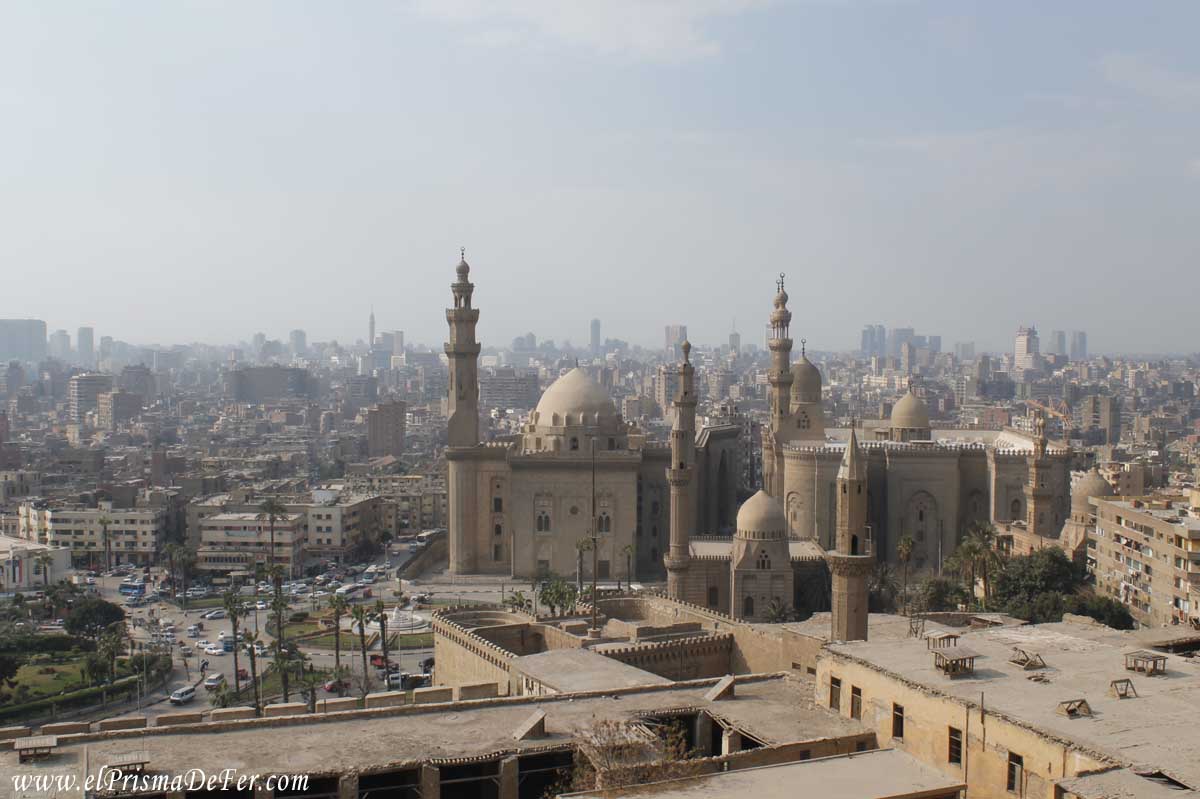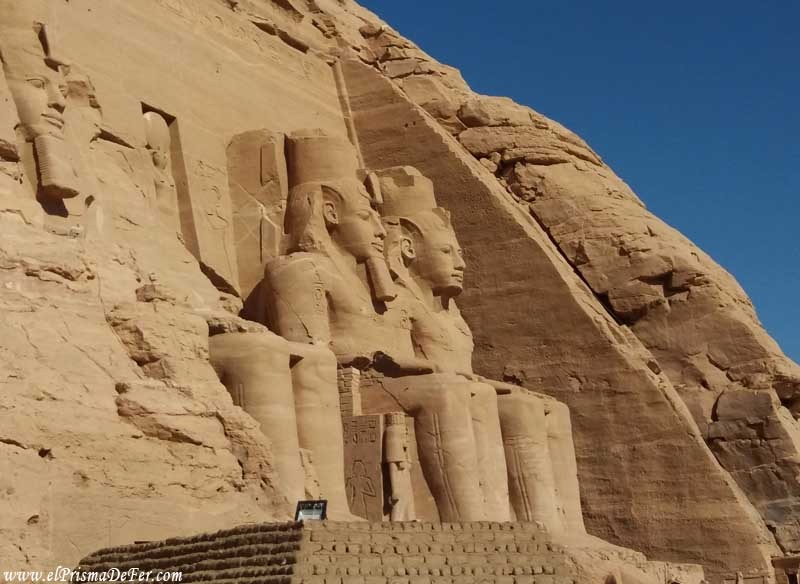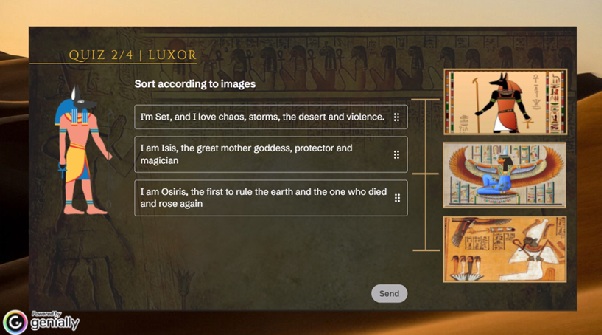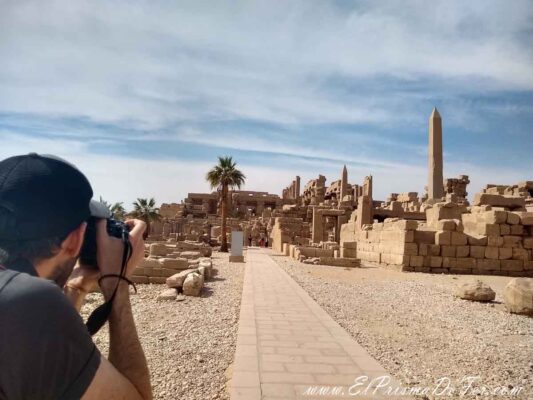Aswan, located on the banks of the Nile and surrounded by a desert landscape, exudes a calm unlike the one I had felt in Cairo. Its pace of life is slower, the people seem friendlier, and the atmosphere feels like a respite from the chaos of Egypt.
But without a doubt, the highlight of this part of the trip was the visit to the majestic Abu Simbel Temple. Traveling those miles south, almost on the border with Sudan, was totally worth it. Standing in front of the colossal statues of Ramses II and entering their halls decorated with ancient reliefs was one of the most striking images I brought back from Egypt.
In this article, I want to tell you about my time in Aswan and what it was like to arrive at Abu Simbel, one of the most spectacular temples in the world.

Table of Contents
Arrival in Aswan from Cairo
After exploring chaotic Cairo and enduring a 12-hour train ride, we finally arrived in Aswan, in southern Egypt. The city, a perfect base for visiting the temples of Abu Simbel and Philae Island, feels calmer and warmer from the very first moment.
Bathed by the waters of the Nile and surrounded by desert landscapes, Aswan has a much more relaxed pace. As soon as we get off the train, we feel the blend of tranquility and everyday life: markets, feluccas cruising slowly along the river, and the hospitality of the Nubian people who inhabit this region.
As I mentioned, most travelers come to Aswan to see the majestic Temple of Ramses II, better known as Abu Simbel, one of the most impressive monuments in all of Egypt. But the city also has another gem nearby: the Philae Temple, located on an island in the middle of the Nile, ideal for complementing your visit to Aswan.

You might be interested in reading the guide to traveling through Egypt, ideal for planning your adventure.
My impressions of Aswan
The city of Aswan itself didn't strike me as particularly attractive for exploring in depth. Beyond a pleasant walk along the banks of the Nile, where you can enjoy spectacular sunsets while having a drink, I wasn't entirely enamored with the rest of the city. The pace is more relaxed than in Cairo, but the dirt and chaos, albeit to a lesser extent, are still present.
Compared to Cairo, the difference is noticeable from the first moment. Aswan is more peaceful, with a warmer climate and a much more pleasant air. Here, the Nile takes center stage: boats and feluccas constantly crisscross its waters, while large tourist cruise ships wait at the dock to continue their route to Luxor.
Aswan is one of the key points for the cruises that travel the Nile between this city and Luxor, a multi-day trip very popular among tourists looking to combine history and landscape in a much more relaxed way.
In short, most of us who come here do not do so for the city itself, but because Aswan is the gateway to some of the most impressive temples in all of Egypt, such as the Temple of Abu Simbel and the Temple of Philae.
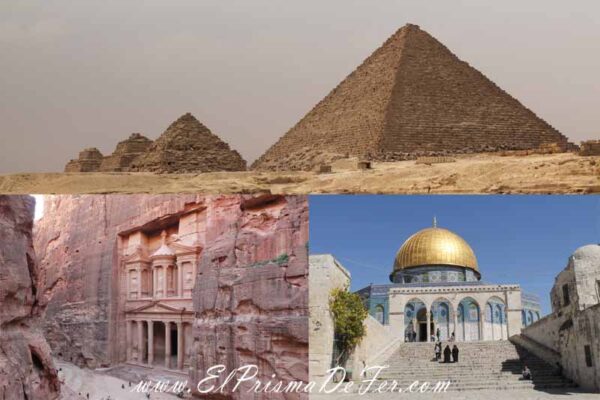
This article is part of the 2-week itinerary traveling through Egypt independently, which in turn belongs to the trip we made also getting to know Jordan and Israel.

What to do in Aswan
Although Aswan isn't the most attractive city in Egypt to explore from end to end, there are some local experiences that may be worthwhile. One of them is browsing its Nubian markets, full of spices, colorful fabrics, and handicrafts. It's a good place to see the daily life of the region and, if you're brave enough, haggle for a souvenir.
Another recommended activity is taking a felucca ride, the traditional sailing boats that travel along the Nile. It's a different way to experience the tranquility of the river and disconnect from the noise of the city.
You can also visit nearby islands, such as Elephantine, where Nubian communities still live and ruins of ancient temples are preserved, or simply relax in a cafe facing the Nile and let time pass.
In Aswan we can also find the famous Unfinished Obelisk, a granite giant that was never finished. Measuring over 40 meters and weighing 1,200 tons, it showcases the carving techniques and ingenuity of the ancient Egyptians and allows us to imagine how monumental it would have been had it been completed.
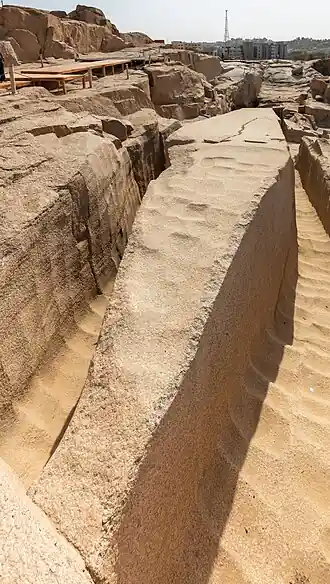
Excursions from Aswan
Most travelers arrive in Aswan with one clear goal: to visit some of the most spectacular temples in all of Egypt.
Abu Simbel
The most famous is, without a doubt, Abu Simbel, the impressive complex built by Ramses II in honor of the gods and his own greatness. Its colossal rock-carved statues and interior decorated with reliefs make it one of those places worth traveling so far to.
Temple of Philae
Another must-see site is the Temple of Philae, dedicated to the goddess Isis. What makes this temple special is that it's located on an island in the middle of the Nile, which requires arriving by boat. The setting, with the water surrounding the sanctuary and the contrast with the desert, makes it one of the most picturesque places to visit in the country.
Both excursions are the real reason Aswan features on most Egyptian itineraries. And believe me, after seeing them in person, they completely justify the long trip to the south of the country.
Temples of Edfu and Kom Ombo
From Aswan, it is also possible to take excursions to other notable temples in southern Egypt, such as Edfu and Kom Ombo.
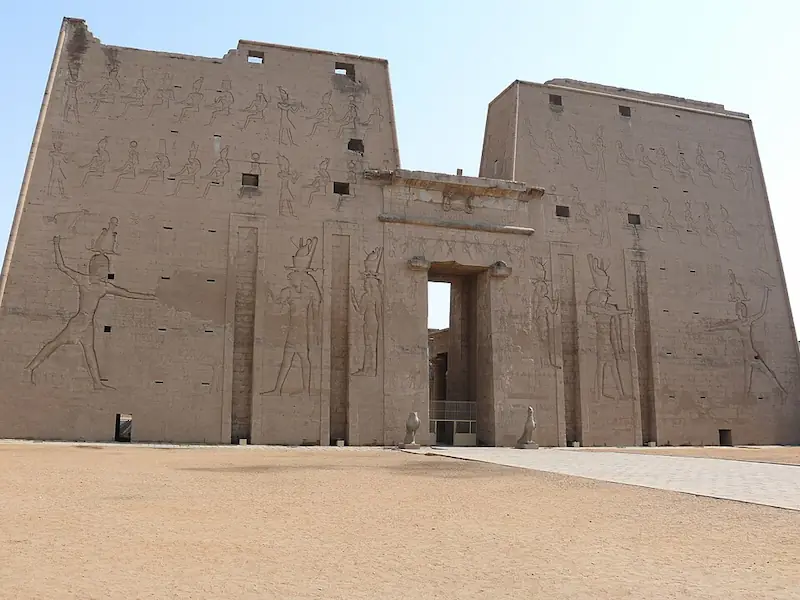
- The Temple of Edfu is dedicated to Horus and is one of the best preserved in all of Egypt, with impressive reliefs and hieroglyphics depicting the religious life of the Pharaonic era.
- Kom Ombo, for its part, is a double temple dedicated to Sobek, the crocodile god, and Haroeris, with unique architectural details and the curiosity of having two symmetrical entrances and sanctuaries.
Both tours can be done by boat or on an organized excursion from Aswan, and are perfect for completing a Nile itinerary.
How to organize your trip to Abu Simbel
Visiting Abu Simbel requires some planning, as it is almost 280 km south of Aswan, near the border with Sudan. Most tours leave early in the morning (around 4:00 am) so you can be back in Aswan by noon.
The most common ways to get there are:
- Bus/minibus tour: This is the most common option. It's easily booked through local agencies or even hotels. The journey takes about 3–4 hours along a desert route.
- Flight from Aswan: Egyptair offers daily flights connecting both cities in less than an hour. It's more expensive, but also much more comfortable and faster.
- Private tour: You can hire a car with a driver, which gives more flexibility in schedules, although the price is much higher than a regular tour.
- Public transport: There is an option to get to Abu Simbel by public transport, but it is more uncertain (I detail it below).
The main difference between booking the excursion in one place or another is basically the price. We booked it directly through our hotel and paid around 450 pounds per person, including the ferry crossing and hotel breakfast.
We later realized that other tourists traveling with us in the same van had paid 325 pounds, and some even up to 1,000 pounds. The activity was identical for everyone, but clearly the bargaining made the difference.
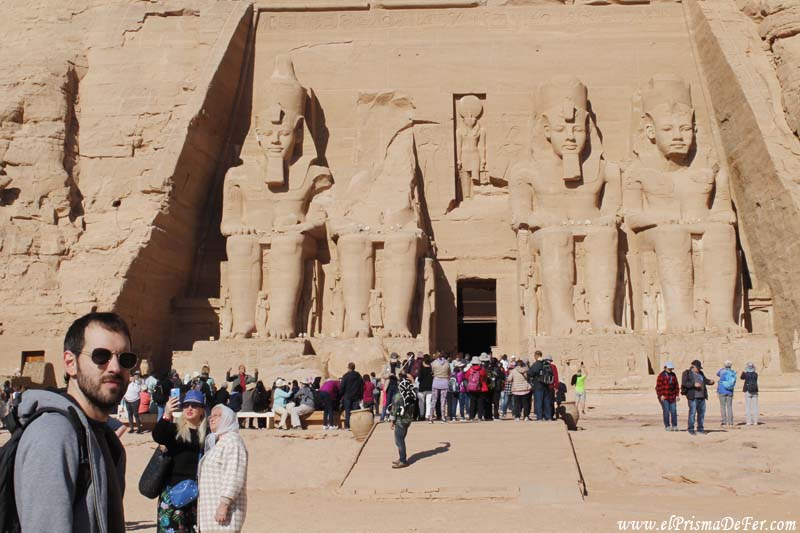
Upon arrival at the complex, you have about two hours to explore the temples and then return. Although getting up early may seem overwhelming, the experience of seeing Abu Simbel with your own eyes makes the effort absolutely worthwhile.
Fees to enter the Temple of Abu Simbel
The entry fee in 2025 is £822 per person and £445.5 for students (only accepted with a printed ID). If you wish to bring professional cameras into the grounds, it is an extra charge (if you use a cell phone, it is not necessary). In any case, I recommend confirming the last value from the official site.
Can you visit Abu Simbel on your own?
Yes, you can, although it's not the most common option. Most travelers arrive at Abu Simbel on organized tours from Aswan, which usually leave very early in the morning in convoys of buses and minibuses. This means that practically all groups arrive at the same time, and the complex fills up quickly.
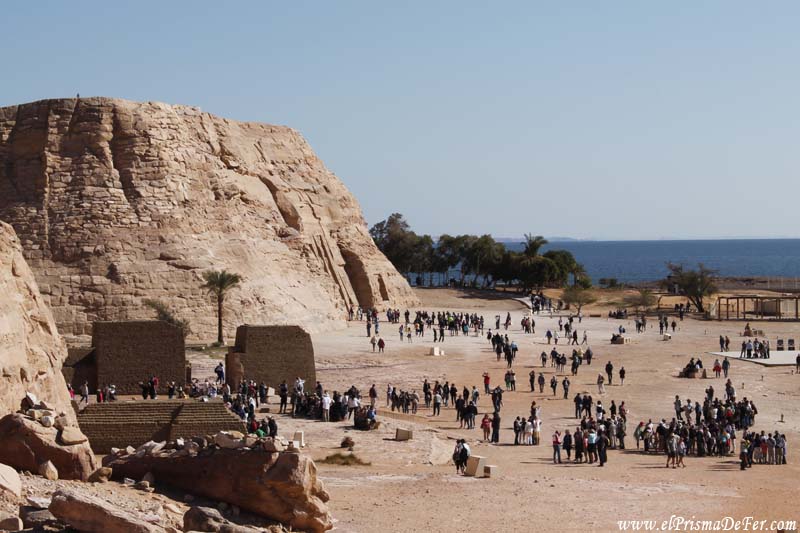
Going on your own involves a bit more logistics, but also the possibility of enjoying the place more calmly. You can hire a private car with a driver in Aswan (a much more expensive option), or even stay overnight in the small village of Abu Simbel, which is very close to the temples.
This last option is ideal if you want to explore them early in the morning or stay until closing time, when there are hardly any tourists and the visit becomes much more intimate.
Take public transport to Abu Simbel village
Local buses depart from Aswan to the village of Abu Simbel, taking about four hours to travel the 280 km of desert between the two sites. They aren't as convenient as an organized tour, nor are they as frequent (there are usually one or two per day, early in the morning and another at midday), but they are the most economical option.
But I recommend researching this option further, as I've read on several blogs that sometimes these buses don't run on schedule or can even get you off at checkpoints along the route, so this is something to keep in mind before deciding to take this option.
Furthermore, buses are not designed to return on the same day with enough time, so the ideal, if you use this option, is to stay overnight in the town of Abu Simbel and visit the temples at dawn or close to closing time, when the large groups are no longer there. From the village, you can walk to the temples or take a taxi for a few minutes.
In our case, we decided to play it safe and go for the safe option. We only had two days to explore Aswan and its temples, so I preferred to keep things simple. Besides, the bad experience we had trying to visit the Pyramids of Giza on our own made me lean toward a more reliable option this time.
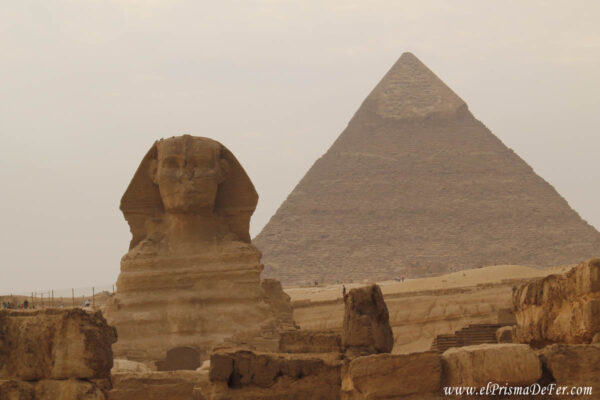
If you want to know more about the experience we had at Visit the Pyramids of Giza on our own, you can read it from this link.
History of Abu Simbel
The Temple of Abu Simbel was built by order of Ramesses II in the 13th century BC, during the height of Egypt's New Kingdom. Its purpose was not only religious but also political: it sought to worship the gods Amun, Ra-Horakhty, and Ptah, but above all, to glorify the pharaoh himself and demonstrate his power to the peoples of the south, on the border with Nubia.
The complex consists of two temples carved directly into the rock: the Great Temple of Ramses II, with its imposing 20-meter-high statues on the façade, and the Temple of Nefertari, dedicated to his favorite wife. Abu Simbel's monumentality makes it one of the most impressive examples of pharaonic architecture.
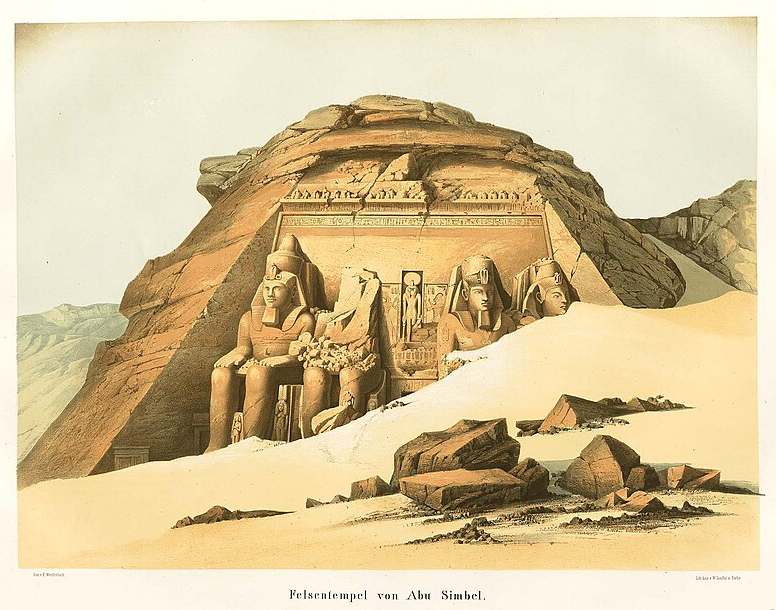
A fascinating detail is the solar phenomenon that occurs twice a year (in February and October), when the sun's rays illuminate the interior of the sanctuary and bathe the statues of the gods and that of Ramses II himself in light. This event demonstrates the Egyptians' advanced astronomical knowledge.
Centuries later, the temple lay buried beneath the desert sand until it was rediscovered in 1813. But perhaps the most incredible part of its history occurred in the 20th century: when the Aswan Dam was built, Abu Simbel was in danger of being submerged under the waters of Lake Nasser. Between 1964 and 1968, in an international operation led by UNESCO, the temples were dismantled stone by stone and rebuilt on higher ground, just as we see them today.
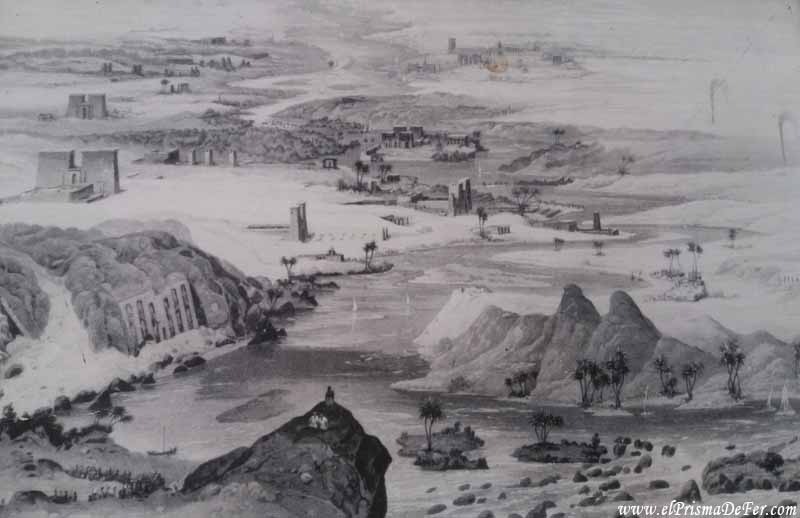

My visit to the Temple of Abu Simbel
The two hours I spent at the complex felt like a lifetime. I would have loved at least two more hours to explore it at my leisure. Abu Simbel deserves time, to carefully observe both the exterior and interior, to walk around a bit after the long journey, to sit and reflect, to eat something, and, of course, to take hundreds of photos. The place has a unique mystique, and the first impression you get when you stand before those colossal stone statues is one that will stay with you forever.

About the Temple of Ramses II (Abu Simbel)
The four colossi of Ramses II on the façade are the most striking feature of the temple. It's impossible not to want to photograph them again and again from every angle. The day I visited, one of them was damaged, with its upper part slumped in front of the entrance, which, far from ruining the scene, gave it an even more imposing air. I hope they manage to restore it in the future.
If you like photography, be prepared, because getting a clean, crowd-free shot is tricky. Most tours arrive and depart at the same time, which means the area can be packed with visitors at the same time.
To enjoy it alone, you'd have to go on your own or even sleep in the small nearby village, which would give you the opportunity to visit outside of peak hours. I'm sure experiencing that silence, alone in front of those pharaonic guardians, must be an unforgettable experience.
The interior of the Great Temple of Ramses II is smaller than I expected, but no less fascinating.
Imposing statues line the central corridor, while the walls and ceilings are completely covered in reliefs and hieroglyphics. The level of preservation is impressive: each room invites you to stop, look closely, and lose yourself in the symbolism that covers every corner.
Temple of Nefertari
Nearby is the Temple of Nefertari, built by Ramses II in honor of his favorite wife. Although smaller in size, it also has a spectacular façade and a well-preserved interior.
Compared to what I had seen in photos, both temples seemed much more impressive in person, far exceeding my expectations.

How to visit the Philae Temple on your own
Al regresar de la excursión a Abu Simbel, cerca del mediodía, nos dimos cuenta de que la ruta pasaba cerca del puerto desde donde salen los barcos hacia el Temple of Philae, another of Aswan's great attractions.
We asked the driver if he could drop us off there, and he agreed. We walked along the road for a few minutes until we reached the port, surrounded by craft stalls and food stalls. The boats that take you to the island depart from there.
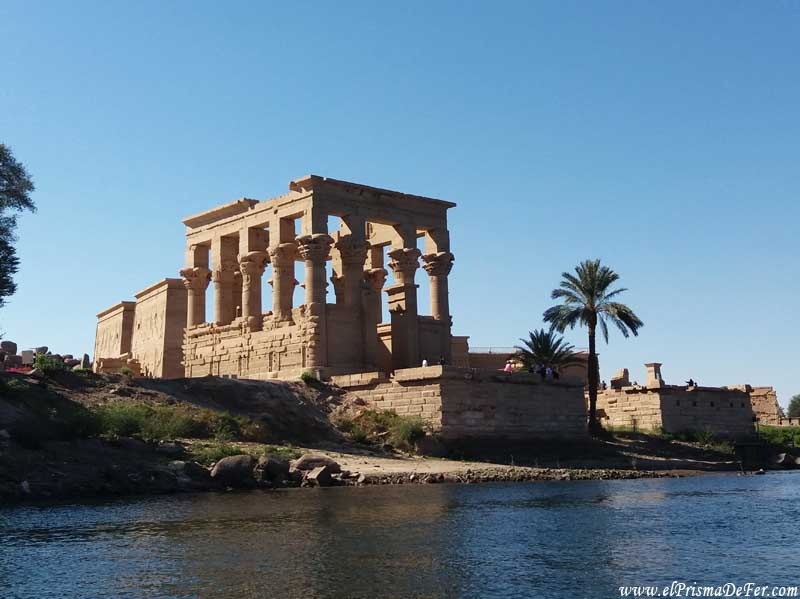
After some negotiation, we agreed to pay, at that time, about 200 pounds for the boat, which would wait for us for about an hour and a half while we toured the temple and would bring us back.
On the island, you can see several buildings, especially the imposing Temple dedicated to Isis. There are also other buildings of great historical value, such as the Temple of Hathor, the Trajan's Gate and the pylons that mark the entrance to the complex.
Like Abu Simbel, this temple was relocated stone by stone during the construction of the Aswan Dam, preserving its magnificence and remaining very close to its original location.
Getting back to Aswan is easy: taxis leave from the same port where we began the journey, but you'll have to negotiate the price.
Entrance to the temple in 2025 costs £550 per person (£275 with a student card). Check the official website for the latest prices.
Where to stay in Aswan
We stayed at the Nuba Dool Guest House Located on Elephantine Island. It is a small island in the middle of the Nile River where they live Nubians Mainly, very friendly and warm people to talk to.
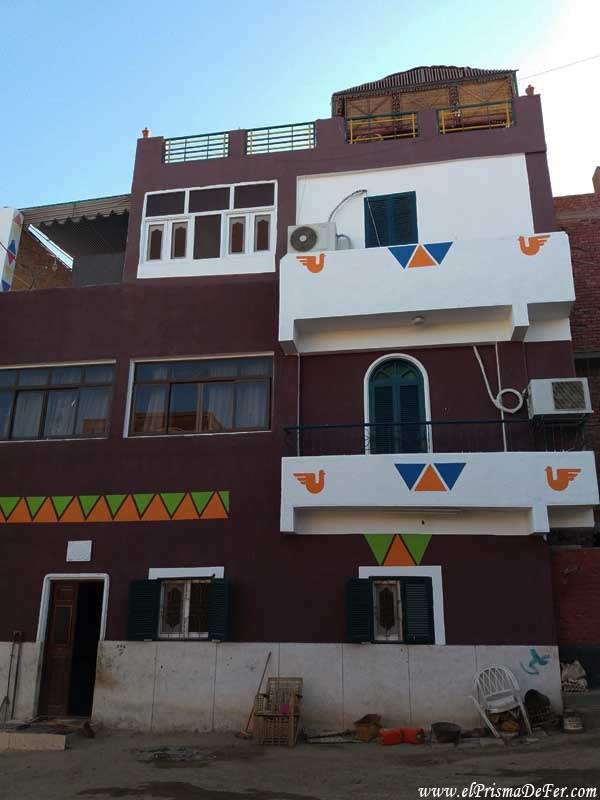
We were treated excellently from the moment we arrived. The location is great. It has a beautiful terrace where you can relax and watch the river at any time. Plus, being on the island, you can't hear the noise of the city's cars.
The downside is that to get there, you have to cross the Nile River using the public ferry, located a few miles south of the train station. There are several private boats that offer crossings to the island, but they generally cost more than the public ferry. Every time you want to go back and forth to the West Bank, you'll have to use the ferry.
Tips for visiting Abu Simbel
- Bring food and water from Aswan: At Abu Simbel, the selection is limited and the prices are quite high, so it's best to arrive prepared.
- Avoid rush hour: Tours usually arrive around the same time. If you can, try to go early or a little later to explore the temple when there are fewer people around.
- Sun protection: The sun in southern Egypt can be intense, so a hat, sunglasses, and sunscreen are essential.
- Tours vs. on your own: While you can get there on your own, many prefer an organized tour for safety and convenience, especially if time is limited.
Is it safe to visit Abu Simbel?
Yes, it's safe for now (although in Egypt you never know 😅). It's said that the vans usually leave in convoys at the same time for safety reasons. There have been some incidents in the past on the desert road between Aswan and Abu Simbel, but the truth is, nothing has happened for years. I assume this measure is mainly in place to control tourist traffic and prevent vehicles from circulating in the area at any time.
How to get from Aswan to Luxor
I decided to travel from Aswan to Luxor by train, and it was a cheap, comfortable, and very nice way to travel. Taking the train isn't complicated; just go to the station and buy the first train departing for Luxor.
There are several services throughout the day, so coordinating schedules is usually not a problem. The trip takes approximately three hours and allows you to enjoy the Egyptian landscape while comfortably traveling between the two cities.
Also, if you'd like, you can take advantage of the opportunity to stop and visit temples along the way, such as the Temple of Edfu or Kom Ombo. We didn't do this because we'd have to carry our luggage down the hill, take a taxi to visit them, and then wait for another train. While it's a cost-effective way to explore the temples on your own, it's much more tiring.
Nile Cruises: From Aswan to Luxor
Another very popular way to travel between Aswan and Luxor is aboard a Nile cruise. These tours not only allow you to travel from one city to the other, but also allow you to enjoy the riverside scenery, riverside villages, and temples along the river, such as Kom Ombo and Edfu.
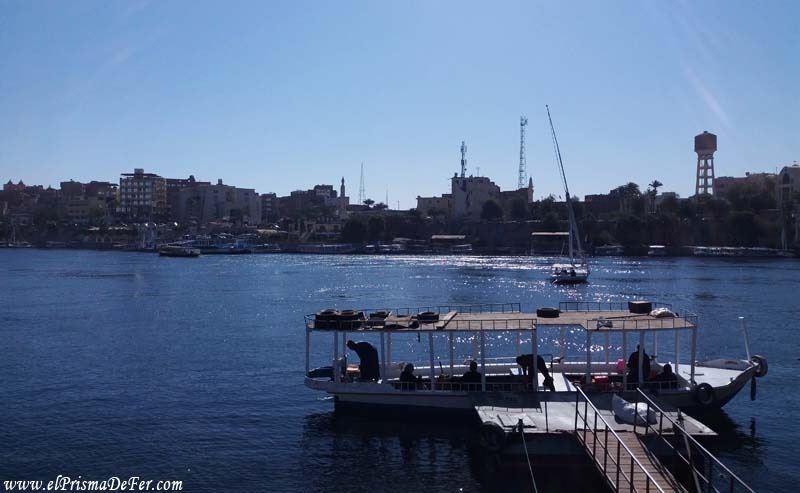
Cruises typically last between three and four days, including meals, accommodations, and guided tours of some of the most important temples in southern Egypt. This is a comfortable and relaxing option, ideal for those who want to combine transportation and sightseeing, enjoying a more leisurely journey while soaking up the history and culture of the Pharaohs.
Is Abu Simbel worth visiting?
Visiting Abu Simbel is an experience well worth the effort. These colossal temples, carved into the rock over 3,000 years ago by order of Ramses II, are impressive not only for their scale and detail, but also for their history. Seeing them in person, in the middle of the desert and on the shores of Lake Nasser, is like stepping back in time. Plus, knowing that the entire complex was moved stone by stone to save it from rising waters after the construction of the Aswan Dam adds even more value to the visit. It's one of those places that truly leaves you speechless.
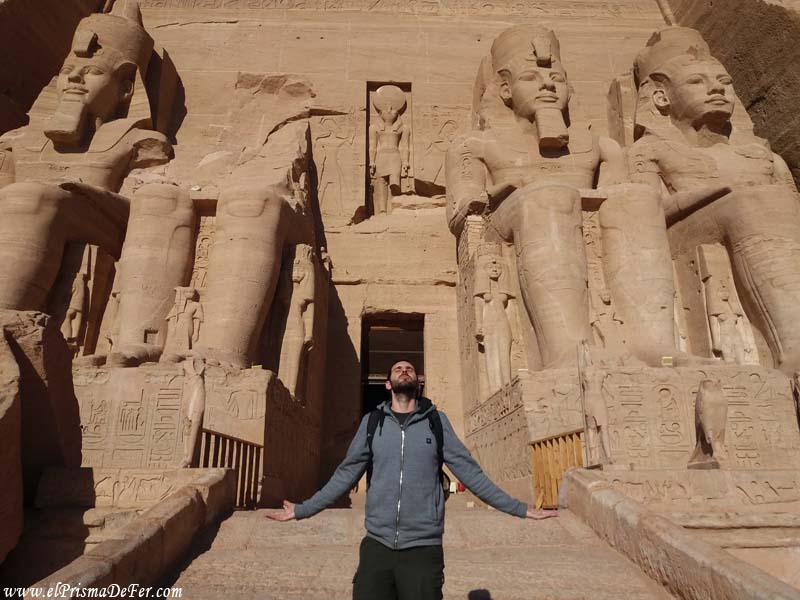
It doesn't matter that we have to travel so far to visit it. If you're in Egypt and you enjoy history or exploring monumental sites, I'd set aside a few days to dedicate to this archaeological gem.
Support The Prism of Fer!
Your support helps me continue creating free content on the blog. Thank you so much!


